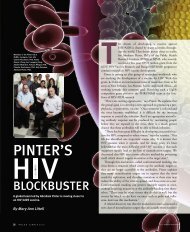changing the course of stroke - New Jersey Medical School ...
changing the course of stroke - New Jersey Medical School ...
changing the course of stroke - New Jersey Medical School ...
You also want an ePaper? Increase the reach of your titles
YUMPU automatically turns print PDFs into web optimized ePapers that Google loves.
and by creating an escape conduit, preserves and/or restores lost<br />
sight.<br />
Turbin says that <strong>the</strong>re is also a constant influx <strong>of</strong> very severe<br />
trauma that is extremely challenging for <strong>the</strong> surgical team at<br />
University Hospital. The eye trauma surgeons are part <strong>of</strong> that<br />
team. “You need aggressive techniques to put a person back<br />
toge<strong>the</strong>r after high speed car crashes, and penetrating gun and<br />
knife injuries, many <strong>of</strong> which cause serious damage to <strong>the</strong> eyes,”<br />
he comments. “These kinds <strong>of</strong> challenges improve our abilities<br />
as thinkers and as surgeons.”<br />
LASIK and Beyond<br />
The sight restoring Excimer laser wowed doctors and<br />
consumers alike when it came on <strong>the</strong> scene with much<br />
fanfare in <strong>the</strong> mid-’90s. “The initial application <strong>of</strong> <strong>the</strong><br />
laser to eye care was a giant leap,” says Peter Hersh, MD, pr<strong>of</strong>essor<br />
<strong>of</strong> ophthalmology at NJMS and <strong>the</strong> lead author <strong>of</strong> <strong>the</strong><br />
clinical study which led to FDA approval <strong>of</strong> <strong>the</strong> Excimer laser<br />
for correction <strong>of</strong> nearsightedness in 1995.<br />
LASIK uses <strong>the</strong> Excimer laser to sculpt <strong>the</strong> cornea’s surface<br />
“much like sandpaper works on wood,” explains Hersh, who is<br />
director <strong>of</strong> refractive and corneal surgery. LASIK is done under<br />
a “corneal flap.” In PRK, <strong>the</strong> cornea is reshaped following <strong>the</strong><br />
removal <strong>of</strong> surface epi<strong>the</strong>lial cells. PRK is used if a patient has a<br />
thin cornea or problems with <strong>the</strong> surface <strong>of</strong> <strong>the</strong> cornea. In <strong>the</strong><br />
new LASEK procedure, <strong>the</strong> epi<strong>the</strong>lial cells are preserved while<br />
<strong>the</strong> laser treatment is done without a LASIK flap.<br />
Over <strong>the</strong> years, laser technology has become “more dependable<br />
and safe,” according to Hersh. Wave front technology—<br />
adapted from astronomy—provides more accurate measurements<br />
to use in programming <strong>the</strong> laser with <strong>the</strong> hope <strong>of</strong><br />
improving results still more and minimizing side effects.<br />
Hersh’s fascination with new devices is still leading him into<br />
uncharted territory. His was one <strong>of</strong> five sites nationwide selected<br />
to perform trials on conductive keratoplasty (CK), which<br />
uses radi<strong>of</strong>requency energy, ra<strong>the</strong>r than lasers, to reshape <strong>the</strong><br />
cornea for <strong>the</strong> treatment <strong>of</strong> farsightedness. The procedure does<br />
not require ei<strong>the</strong>r a surgical flap or removal <strong>of</strong> surface epi<strong>the</strong>lial<br />
cells, and can be done in 5 to 10 minutes per eye in <strong>the</strong> physician’s<br />
<strong>of</strong>fice. Hersh presented <strong>the</strong> CK clinical study results to <strong>the</strong><br />
FDA last year, and <strong>the</strong> procedure was recently approved by <strong>the</strong><br />
FDA. This procedure is designed for patients over 40 years old<br />
who have farsightedness and need reading glasses.<br />
“We now have a variety <strong>of</strong> procedures and technologies to<br />
use, and we can suggest <strong>the</strong> treatment option best for that person,”<br />
he says. “We are also better at picking and choosing who<br />
22<br />
PULSE SPRING 2003<br />
Diabetic macular<br />
edema (above).<br />
“Technological<br />
development<br />
is so fast that <strong>the</strong><br />
ability to be at<br />
<strong>the</strong> forefront <strong>of</strong><br />
new technologies<br />
is very important.”<br />
will do well, so <strong>the</strong><br />
— Peter Hersh<br />
range <strong>of</strong> people who can<br />
be successfully treated is<br />
greatly increasing.”<br />
Hersh feels that <strong>the</strong> speed at which laboratory and clinical<br />
research findings move into <strong>the</strong> realm <strong>of</strong> patient care is one <strong>of</strong><br />
<strong>the</strong> greatest advantages <strong>of</strong> <strong>the</strong> academic setting. Leading <strong>the</strong> trials<br />
that establish <strong>the</strong> safety and efficacy <strong>of</strong> new technologies and<br />
devices means more experience and so more skill in handling<br />
<strong>the</strong> complex cases safely. He also does about 120 corneal transplants<br />
each year and is research director <strong>of</strong> <strong>the</strong> <strong>New</strong> <strong>Jersey</strong> Eye<br />
Bank, which he says is one <strong>of</strong> <strong>the</strong> best in <strong>the</strong> country.<br />
“Technological development is so fast that <strong>the</strong> ability to be at<br />
<strong>the</strong> forefront <strong>of</strong> new technologies is very important,” he concludes.<br />
“We are helping to lead <strong>the</strong> development <strong>of</strong> technologies<br />
to restore sight.”<br />
The NJMS Institute<br />
<strong>of</strong> Ophthalmology and<br />
Visual Science<br />
Dealing with <strong>the</strong> unusual, <strong>the</strong> exceptionally complex,<br />
<strong>the</strong> seemingly unresolvable, <strong>the</strong> horrific, and disorders<br />
and injuries requiring a multifaceted team are what an<br />
academic medical program is charged with. Teaching <strong>the</strong> next<br />
generation <strong>of</strong> eye specialists <strong>the</strong> state-<strong>of</strong>-<strong>the</strong>-art and inspiring in<br />
<strong>the</strong>m a devotion to <strong>the</strong> science demand patience, skill, knowledge,<br />
lots <strong>of</strong> hours, many hands, and more than a few flashes <strong>of</strong><br />
brilliance. Among <strong>the</strong> cast:<br />
Marco Zarbin, MD, PhD, Chair • A visionary (no pun<br />
intended) who has built up <strong>the</strong> academic department and led<br />
<strong>the</strong> group to <strong>the</strong> top <strong>of</strong> <strong>the</strong> charts in record time. A retinal surgeon<br />
specializing in age related macular degeneration (AMD),<br />
his research focuses on sight-restoring <strong>the</strong>rapies for those in <strong>the</strong><br />
later stages <strong>of</strong> <strong>the</strong> disease. During <strong>the</strong> last eight years, his laboratory<br />
has made major progress in transplantation <strong>of</strong> retinal pigment<br />
epi<strong>the</strong>lium (RPE) cells. His research goal for <strong>the</strong> department<br />
is “to cure blindness.” He’s <strong>the</strong> author <strong>of</strong> <strong>the</strong> CME module<br />
on age-related macular degeneration following this story.<br />
Larry Frohman, MD, Vice Chair • A highly respected<br />
neuro-ophthalmologist, his clinical focus ranges from <strong>the</strong> effects<br />
<strong>of</strong> neurological, infectious, and immunological systemic dis-<br />
NATIONAL EYE INSTITUTE, NIH






